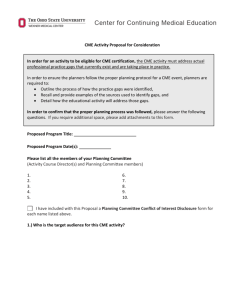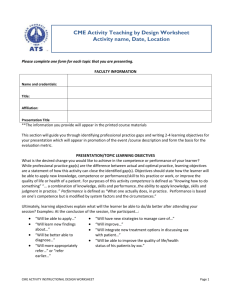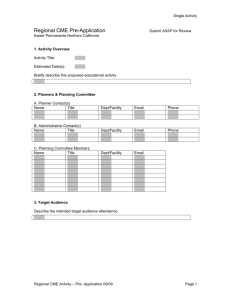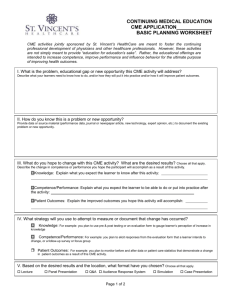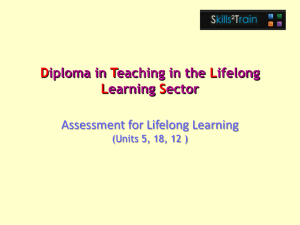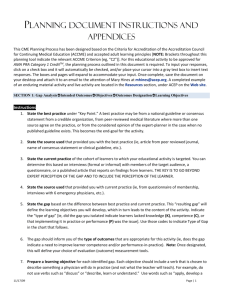Identification of Professional Practice Gaps, Educational Needs
advertisement
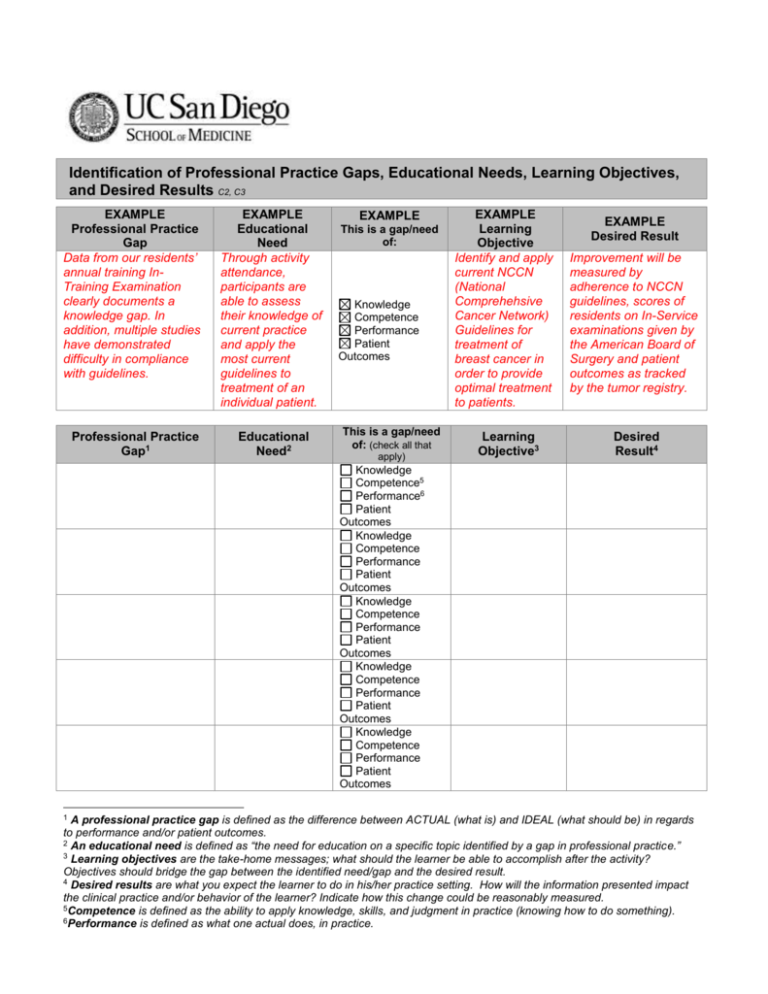
Identification of Professional Practice Gaps, Educational Needs, Learning Objectives, and Desired Results C2, C3 EXAMPLE Professional Practice Gap Data from our residents’ annual training InTraining Examination clearly documents a knowledge gap. In addition, multiple studies have demonstrated difficulty in compliance with guidelines. EXAMPLE Educational Need Through activity attendance, participants are able to assess their knowledge of current practice and apply the most current guidelines to treatment of an individual patient. Professional Practice Gap1 Educational Need2 EXAMPLE This is a gap/need of: Knowledge Competence Performance Patient Outcomes This is a gap/need of: (check all that apply) EXAMPLE Learning Objective Identify and apply current NCCN (National Comprehehsive Cancer Network) Guidelines for treatment of breast cancer in order to provide optimal treatment to patients. Learning Objective3 EXAMPLE Desired Result Improvement will be measured by adherence to NCCN guidelines, scores of residents on In-Service examinations given by the American Board of Surgery and patient outcomes as tracked by the tumor registry. Desired Result4 Knowledge Competence5 Performance6 Patient Outcomes Knowledge Competence Performance Patient Outcomes Knowledge Competence Performance Patient Outcomes Knowledge Competence Performance Patient Outcomes Knowledge Competence Performance Patient Outcomes 1 A professional practice gap is defined as the difference between ACTUAL (what is) and IDEAL (what should be) in regards to performance and/or patient outcomes. 2 An educational need is defined as “the need for education on a specific topic identified by a gap in professional practice.” 3 Learning objectives are the take-home messages; what should the learner be able to accomplish after the activity? Objectives should bridge the gap between the identified need/gap and the desired result. 4 Desired results are what you expect the learner to do in his/her practice setting. How will the information presented impact the clinical practice and/or behavior of the learner? Indicate how this change could be reasonably measured. 5Competence is defined as the ability to apply knowledge, skills, and judgment in practice (knowing how to do something). 6Performance is defined as what one actual does, in practice. Additional needs/gaps, objectives, desired results attached Identification of Needs, Desired Results, Learning Objectives, and Outcomes Step 1: Organize the needs into a prioritized list - now that the needs and gaps have been identified, organize them into the most important needs/gaps that will be used to develop the CME activity. Please state the prioritized needs in the left column of the worksheet (one need per Cell) – use only as many slots as you have needs Step 2: Identify the types of deficiencies/quality gaps identified (knowledge, competence, performance) – at least one box must be checked per row in the CME application. Is the need related to… Giving physicians’ new knowledge? Giving physician’s new abilities/strategies? Helping physicians’ modify their practice? This would be a gap in… Knowledge Competence Performance Step 3: Identify the desired results according to the identified need – these will be the teaching goals for this activity. It also identifies issues that can be measured three months post-activity in an outcomes evaluation. Step 4: Prepare learning objectives - Visualize the learning objectives for this activity as stepping stones that enable you and your faculty to take the learner from the identified need to the desired result. In addition, learning objectives must be written from the perspective of what you expect the learner to do in the practice setting with the information you are teaching. NOTE: verbs that communicate acquisition of knowledge: cited, define, describe, identify, list; comprehension: describe, discuss, explain, interpret; application: apply, demonstrate, review, translate; evaluation: appraise, determine, recommend. Verbs to avoid: appreciate, know, learn, and understand. Instructions to assist with writing learning objectives are located on the UC San Diego CME web site. Step 5: Identify appropriate activity evaluation and follow-up outcomes evaluation questions – Good adult education seeks to measure the effectiveness of its activities. At the conclusion of the activity, participants will evaluate the quality of the activity, learner satisfaction, applicability to the practice environment, the appearance of bias in the instructional process, and quality of the faculty. In addition, the participants will be asked to answer the outcomes measurement questions identified in the CME worksheet; this data will be utilized to assess change. It is recommended that all faculty/speakers/ authors be provided with the results of these evaluative measurements.
